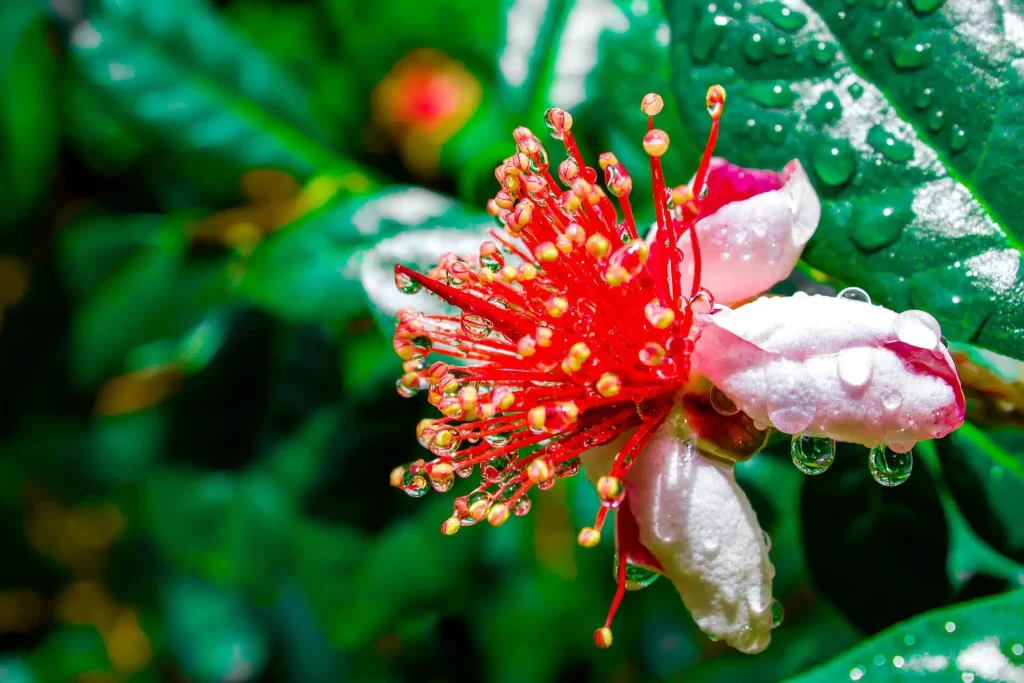After reading this guide, you will be familiar with the different species of guava.
Overview
Guava is one of the diverse groups of fruits, which is widely consumed either fresh or processed such as in beverages, syrup, and ice cream.
The fruit of guava is high in dietary fiber, which is found to be around 48.55-49.42% and extractable polyphenols 2.62-7.79%.
Guava provides numerous health benefits, ranging from sugar reduction, cancer treatment, skin disease treatment, heart disease treatment, and so on.
However, not all species of guava are equal, and therefore knowing the different species is important in separating the species with the most economic and ecological importance.
Learn more on the different varieties of guava here and click here to learn more about the botany of guava plant
Below are the common species of guava:
Mountain guava (Psidium amplexicaule Pers.)
Mountain guava is a scientifically known Psidium amplexicaul. It is a wild species of the common guava (Psidium guajava). Mountain guava is native to the Caribbean. It is also not uncommon on Islands like the Islands of St. Thomas and St. John of the U.S Virgin Islands and also the Islands of British Virgin of Tortola and Virgin Gorda.
Mountain guava can be differentiated from other species of guava by the following characteristics:
- Mountain guava posses opposite, slightly round thick and leaves of 1.5 to 2.5 inches (3.75-6.25cm) diameter
- It is usually stalkless
- It posses small flowers that are placed 0.5 inch across the ends of twigs
- The fruit is round, which is about 8/4 inch in diameter
- The calyx lobes are located at the apex of the fruit
- The flower blooms in summer and spring time
- The growth height is estimated to be 2.4 to 3.7 meters
Luquillo Mountain Guava (Psidium calyptranthoides Alain)
This is another wild species of guava that is scientifically known as Psidium calyptranthoides. The species is native to Puerto Rico and is also common in the wet mountain forests, Manricao state, and Luquillo forest.
Related: Magnoliophyta the division of guava plant
Stawberry Guava (Psidium littorale)
Strawberry guava is one of a cultivated species of guava that is native to South America specifically in Brazil.
It is scientifically known as Psidium littorale, which can sometimes be called Psidium cattleianum Sabine.
Common names include strawberry guava, cattley guava, and Chinese guava.
Common features are:
- Strawberry guava can reach upto to a height of 8m
- It has edible round fruit
- The fruit is estimated to be 2-4cm in diametre
- It has an open calyx that is opposite to the stem
- The fruit is initially green and later turn into a deep magenta when fully ripe
- The fruit is soft with thin skin that smells like a rose petals
- The inner part of the fruit is creamy with numerous seeds that can be swallowed whole
- Strawberry fruits have a pleasant aroma like that of strawberry and lime zest
- It is cultivated during the summer
Wild Guava (Psidium friedrichsthalianum)
Wild guava plant is also one of the widely cultivated species of guava that is commonly known in Costa Rica. However, the plant is also cultivated in Guatemala, Nicaragua, and some Central American countries.
It is scientifically known as Psidium friedrichsthalianum.
The fruit of wild guava in Costa Rica is used to make sour and refreshing beverages. Psidium friedrichsthalianum was successfully cultivated in California and using seeds in a few regions.
Common features are:
- Wild guava posses most of the characteristics of tropical guava
- The leaves are oval
- The fruits are green initially and turn to yellow when ripe
- The calyx lobes is at the apex of the fruit

Guava (Psidium guajava)
This is the most widely cultivated and used of all the species of guava. It is common guava that we used in our day to today uses. It is native to Tropical Americas.
It is commonly known as tropical guava and scientifically known as Psidium guajava L.
- It is edible fruit
- The strunk is slender, green or red-brown, and smooth
- The leaves are oval and elliptical
- It has an upper surface leaf area that is smooth and a bottom that is hairy
- The fruit is oval and green to yellow
- The inner part is fleshy, which range in color from white, yellow, pink, and red
Guinea Guava (Psidium guineense Sw.)
Guinea guava is a plant that is native to the tropical and non-tropical Americas. It is also common in Mexico, Argentina, and the Caribbean.
It is scientifically known as (Psidium guineense Sw.). Common names include Brazilian guava, guaya agria, goyavier de Brasil, araca-do-campo, Guavenbaum, Brasil.
Common characteristics include:
- Guinea guava is a shrub of not more than 3 meters, but sometimes can grow up to a 7 meters tree
- It posses grayish bark and foliage
- The length and width of the leaves is approximately 14cm and 8cm respectively
- The leaf-blade is oval and stiff with toothed edges
- Posses a flower with pleasant aroma
- It posses a round fruit that is approximately 2.5cm in diameter
- The outer skin of the fruit is yellow while the part is white in color with numerous seeds

Mangroveberry (Psidium longibes ((Berg.) Mcvough)
The mangroveberry is a rare and threatened wild species of guava. It is an endemic species of Monroe and Miami Dade countries. It is called mangroveberry, but it is not related to the mangrove in any way.
- It is scientifically known as Psidiun longibes
- Distinguishing chacteristics include:
- It is a shruby tree with low spreading
- It can grow upto a ten-foot in height
- It is broad as its height
- It posses glossy green heart shaped leaves that are opposite
- The leaf margin is entire
- The length of the leaf is about 2 inches long
- The flowers grow in clusters of one to four in leaf axils
- The sepals and petals areb in four
- The flower has a pleasant smell
Other species of different varieties are:
- Psidium longibes ((Berg.) Mcvough Var. longibes
- Psidium longibes ((Berg.) Mcvough Var. Orbiculare
Mountain Guava (Psidium montanum Sw.)
Mountain guava is one of the species of guava under the genus Myrtales. The native range of mountain guava is Jamaica.
The scientific name of mpontain guava is called Psidium montanum.
Characteristics include:
- It is a small tree of 10-15m tall
- It posses elliptic, oblong-elliptic or elliptic-lanceolate leaves
- The leaf is 3-9cm and 1-4cm in length and width respectively
- It has solitary flowers, which appears in false racemes because of the falling or failure of leaves to grow
- The leaves have pleasant smell like that bitter almond
- The fruits are greenish in color, which are subglobose
- The diameter of the approximately 2cm
- The fruits have pleasant aroma
Sintenis’ Guava (Psidium sintenisii (Kiaerk.) Alain
Sintenis’ guava is wild guava species and endemic flowering plant of Puerto Rico. It is scientifically known as Psidium sintenisii.
It is mostly found in El Yunque National Forest with three to four subpopulations. Simtenis’ grows in wet mountain forest habitat.
Common names include Sintenis’ guava and hoja menuda.
Distinguishing characteristics include:
- It is upto 9m in height
- The bark is grayish, shreddy, and grooved with greenish branches
- The leaf blades can reach upto 6.3cm long
- The flowers are solitery in axils, which are borne on long stalks
- The fruit is green initially and later turn to yellow
- The fruits are upto 2cm long
Related: Learn the Botany of guava plants

Conclusion
These are some of the common wild and cultivated species of guava. We this guide gives a solid background in understanding the species of guava.
References
Antonio Jiménez-Escrig,*,†, Mariela Rincón,‡, Raquel Pulido,† and, and Fulgencio Saura-Calixto†Journal of Agricultural and Food Chemistry 2001 49 (11), 5489-5493 DOI: 10.1021/jf010147p
Akanda, Md. Khokon & Mehjabin, Sanzia & Uzzaman, Shakib & Parvez, Masud. (2018). A short review on a Nutritional Fruit : Guava. Toxicology Research. 1. 1-8.
File:Crguava.jpg. (2019, June 11). Wikimedia Commons, the free media repository. Retrieved 12:45, May 11, 2020 from https://commons.wikimedia.org/w/index.php?title=File:Crguava.jpg&oldid=354027029.
File:Psidium friedrichsthalianum, the Wild Guava (10841338553).jpg. (2018, January 28). Wikimedia Commons, the free media repository. Retrieved 12:52, May 11, 2020 from https://commons.wikimedia.org/w/index.php?title=File:Psidium_friedrichsthalianum,_the_Wild_Guava_(10841338553).jpg&oldid=283462269
File:Psidium sintenisii.jpg. (2019, June 11). Wikimedia Commons, the free media repository. Retrieved 10:17, May 12, 2020 from https://commons.wikimedia.org/w/index.php?title=File:Psidium_sintenisii.jpg&oldid=354007571.
Wikipedia contributors. (2020, April 22). Psidium cattleyanum. In Wikipedia, The Free Encyclopedia. Retrieved 12:21, May 11, 2020, from https://en.wikipedia.org/w/index.php?title=Psidium_cattleyanum&oldid=952449907
Wikipedia contributors. (2018, November 11). Psidium guineense. In Wikipedia, The Free Encyclopedia. Retrieved 08:09, May 12, 2020, from https://en.wikipedia.org/w/index.php?title=Psidium_guineense&oldid=868354795
Wikipedia contributors. (2019, November 1). Psidium sintenisii. In Wikipedia, The Free Encyclopedia. Retrieved 10:13, May 12, 2020, from https://en.wikipedia.org/w/index.php?title=Psidium_sintenisii&oldid=924032976
Wikipedia contributors. (2020, January 25). Psidium amplexicaule. In Wikipedia, The Free Encyclopedia. Retrieved 09:37, May 11, 2020, from https://en.wikipedia.org/w/index.php?title=Psidium_amplexicaule&oldid=937472783
Wikipedia contributors. (2020, March 4). Psidium friedrichsthalianum. In Wikipedia, The Free Encyclopedia. Retrieved 12:31, May 11, 2020, from https://en.wikipedia.org/w/index.php?title=Psidium_friedrichsthalianum&oldid=943822237
http://powo.science.kew.org/taxon/urn:lsid:ipni.org:names:600923-1
https://specialtyproduce.com/produce/Strawberry_Guavas_8731.php



